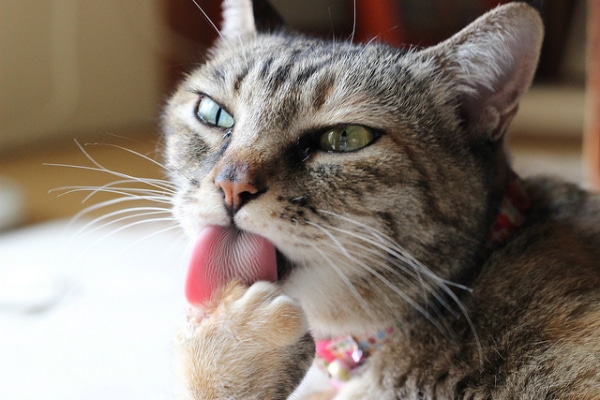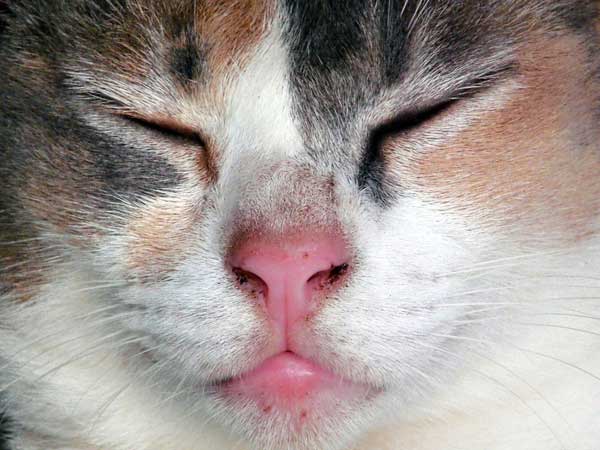If you have a cat with allergies, you may have experienced some frustration in getting on top of the problem. Skin allergies in cats are very common and finding out the cause can be difficult. Cats who react to environmental allergens tend to develop itchy skin but may not obviously scratch, secretive creatures that they are.
Diagnosing allergies often needs veterinary advice, but there are a few trials you can do at home and some easy remedies that do work for some allergic cats. We will also discuss some basic strategies to reduce the allergen load of your home for those itchy cats who don’t respond to other treatment protocols. Here are some tips.

What to look for
In general, cats develop skin disease with allergies. This can be mainly along the back: You’ll see missing, broken hairs on either side of the spine, particularly above the tail.
You may also see little scabs all over the skin, known as miliary dermatitis, or crusty areas around the face and ear. Allergies in many cases are seasonal and worse during spring and summer.
For some cats allergies also cause a swollen nose, ulcers in the mouth, smelly or flaky skin, frequent ear infections, and even increased vomiting (often due to hairballs). Cats with allergies are often a bit grumpy. They may hide a lot or twitch their skin.
Interestingly, you may not see obvious scratching in your allergic cat. Our feline friends are notoriously secretive, so the only thing you may see is skin changes and perhaps a slight increase in grooming behavior, or your cat may be hiding more frequently to groom in private.

But what is my cat allergic to?
The tricky part is that there are so many potential causes. Your cat may be allergic to something in your carpets or furnishings, dust mites, pollens, grasses, cleaning products, fleas, or food proteins. In some cases the allergic response and changes in your cat’s skin are not immediate, so it may not be obvious what started all that over-grooming.
Allergies are not something your cat is born with; they develop over time with repeated exposure to the allergen, usually by three years of age. That being said, some types of allergies are more acute in onset, such as insect bite reactions that can result in hives and itchy weals.
Many cats have multiple allergies, so finding one single cause is often not possible. In many cases your cat may be able to tolerate low levels of one allergen, but as more and more exposure occurs to multiple allergens, this could push him over the itch threshold.

Even if you can’t keep your cat in an allergen-free bubble, it may be possible to at least reduce the overall allergen load of the house. Common causes of seasonal allergies in cats are:
- Dust mites
- Pollens
- Molds
- Fleas
- Cat litter
- Grasses/plants
- Dust
What is the first step?
If you haven’t already done so, please visit your vet. In many cases, such as with mosquito bite allergies or flea allergies, the cause is immediately obvious and you can work on reducing exposure and potentially solve the problem for you and your cat.
A cat who has a swollen nose with little scabs along the bridge quite likely has a mosquito allergy. Mosquito bite allergies rely on good control of mosquitoes around the home during the warmer months. In some areas, keeping your cat indoors is a great option.

If your cat has a flea bite allergy, it is often worse in spring and summer and usually it starts around the base of the tail first. There may not be obvious fleas; cats are incredibly efficient at grooming, so very rarely would you see them crawling with parasites. Allergic cats are so sensitive to the flea saliva injected when a flea bites that one bite can cause two weeks of irritation.
Frustratingly for cats, there is no one flea product that kills fleas and stops them biting immediately. Even the fastest-acting flea products (like Capstar and Comfortis) take a few hours to kill each flea. The aim is to reduce flea numbers in the environment with flea bombs, washing bedding, treating all in-contact pets, and keeping lawns short.
Your vet will also want to check for secondary infections, fungal disease, and mites that might be complicating things. If your cat has self-traumatized himself enough that there are scabby areas, the skin is thickened and there is an ulcerated, open area of skin, it is most likely time for some antibiotics or even anti-fungal meds. Once the skin is healthy again, the allergy itself can be tackled and you can develop a treatment and diagnostic plan with your vet.

Conduct a food trial
If your pet has a food allergy and a pollen allergy, just reducing the food allergy component may reduce the overall allergen load to a more manageable level.
To diagnose a food allergy, you should feed your cat an exclusion diet that does not contain any potential allergens for eight weeks. This can be a home-cooked diet using a meat protein your cat has never eaten before (duck, venison, turkey, or kangaroo), combined with a carbohydrate source like sweet potato.
The easiest way to do a food trial is using a hydrolyzed prescription diet like Hills Z/D. There are a number of foods available for sensitive skin, but they may not be strictly speaking allergen-free enough to truly count as an exclusion diet.
To ensure that the allergy is truly a food allergy, it is essential that you reintroduce the previously fed food to see if the allergy returns. Many allergies will have seasonal fluctuations, and you really want to be sure that you need to be strict with your cat’s diet.
Flea control
Even if your cat doesn’t strictly speaking have a flea allergy, make sure flea control is up-to-date. Because allergic pets are already sensitized, if they get fleas they tend to react quite badly. Use a good-quality product like Frontline, Advantage, Revolution or Comfortis, combined with good environmental flea control. You can also use Capstar every second day for a month, or when fleas are seen, to quickly kill those clever little parasites.
Shampoo therapy and oils
For cats with environmental allergies, often the hair traps pollen granules and dust mite antigens. Using an oatmeal shampoo once a week helps to soothe the skin and rid the coat of allergens. If your cat really dislikes baths, you could also try just wiping down her coat every few days with a damp towel, particularly during pollen season.
Omega-3 fatty acids combined with essential oils that you can apply to your cat’s skin have also been shown to assist cats with allergies. Using a weekly top-spot version can be very effective too.
Antihistamines
While antihistamines don’t work as well in cats as in people, your vet can give you some doses for some safe antihistamines. If they work, they are cheap, effective and very safe. They often work quite well in conjunction with fish oils.
Medications and treatments your vet might recommend
Atopica: This medication has recently been registered for use in cats in Australia. It contains an active ingredient called cyclosporine, which works well for seasonal allergies in cats.
Immunotherapy: If your cat receives testing against a panel of likely allergens, it is possible to in some cases desensitize him to what he is allergic to. This is done via a series of weekly injections of small amounts of the allergen. In some cases a blood test can be used to determine what the likely cause of the allergy is, but in many cases a dermatologist is needed to do skin-patch testing.
Additional strategies to reduce the allergen load
Look at where your cat spends the most time and focus there. Here are some tips:
- Wash your pet’s bedding (and yours, too, if your cat sleeps on your bed), weekly on the hottest cycle in your washing machine. This will kill flea eggs and dust mites.
- During pollen season, keep your pet indoors and use HEPA filters around your home.
- Vacuum weekly if you have carpets and restrict your cat’s access to these rooms. Use a HEPA filter in your vacuum too. Make sure you keep your cat out for a couple of hours after vacuuming.
- Change cat litter, particularly if the litter is dusty (it might be best to do this gradually to avoid problems with your cat refusing to use the new litter).
- Many cats have concurrent food allergies, so consider that food trial, even if you suspect the main cause is a seasonal pollen allergy.
- Furnishings like rugs, curtains, fabric, couches, and beds often harbor allergens like dust mites. There are special covers you can use for the bed to protect your cat if this is a favorite resting spot, or restrict access to areas of the house that have these things.
- If your house has a damp problem, mold spores can trigger allergies. Bathrooms and clothes dryers can be the main culprits, so blocking these areas off or tackling existing mold and increasing ventilation can help.
Does your cat have allergies? How did you discover it and how are your coping? Tell us your strategies in the comments.
Read more about cats with allergies:
- How to Spot the Signs of SeasonalAllergiesin Cats
- 10 Common Cat Skin Problems
- What Causes Cat Sneezing?
- When It Isn’t a Hairball: How I Learned My Cat Has Asthma
- Why Won’t the Sore Heal on My Cat’s Mouth?
About the author: With 7 years of small animal practice, Dr. Eloise Bright came to Love That Pet as animal lover and advocate for all animals from baby birds to stray kittens. With two sons in tow and hubby, Eloise mainly practices in Sydney, Australia. Chat with her and the dog, Duster, and cat, Jimmy, on Google+.







